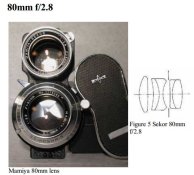clayne
Member
Keep at it Peter. I know you can lick this. Surprised those screws still wouldn't come out.
Keep at it Peter. I know you can lick this.
Peter:
The C330f backs are changeable. Maybe yours has been damaged or installed wrong.

Another important note -- the testing and attempts performed by PeterB above assumes to calibrate the camera so at wide open aperture (i.e. F2.8) the objects are sharply focused. However, TLR cameras are not necessary calibrated in such a way. Due to curvature of field and focus shift (which makes the focus plane shift as you change the aperture), lenses are usually calibrated in a way such as center and corner resolution are sufficiently sharp at two or three stops down. Because for many of such lenses, calibrating for perfect center focus wide open will mean the corner performance will be weak at most apertures until you reach f16 or f22.
So, in short, calibrate infinity focus for a sharp center at f5.6 or f8, not wideopen.
Thanks for all that information. I'm trying to wrap my around this last statement you made. This is common practice when printing from an enlarger, and in a search I wasn't able to find advice against it. How many fractions of a mm will the focal plane (at the film) shift by when stopping down from wide open to f8?
Regards
Peter
Spherical aberration will cause your focus shift. You could roughly characterize the amount of sph abb based on your focus shift but it's pretty much easier to just mark the offset for each aperture setting.

Thanks for all that information. I'm trying to wrap my around this last statement you made. This is common practice when printing from an enlarger, and in a search I wasn't able to find advice against it. How many fractions of a mm will the focal plane (at the film) shift by when stopping down from wide open to f8?
Regards
Peter
Nodda, thanks for your reply. As an experienced LENS DESIGNER, I was wondering if you could quantify the shift in the focal plane when stopping down from f2.8 to f8 in the lens used which is described below. i.e., by how much will the focal plane shift (in mm). This lens' smallest depth of focus (When focussed at infinity) is about 0.25mm.
The lens is a Mamiya Sekor 80mm f2.8. It is a 5 element 3 group design based on the Cook Triplet. (taken from here and Dead Link Removed)
View attachment 97640
| Photrio.com contains affiliate links to products. We may receive a commission for purchases made through these links. To read our full affiliate disclosure statement please click Here. |
PHOTRIO PARTNERS EQUALLY FUNDING OUR COMMUNITY:  |